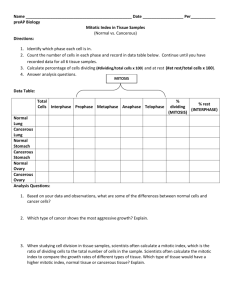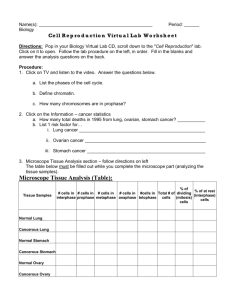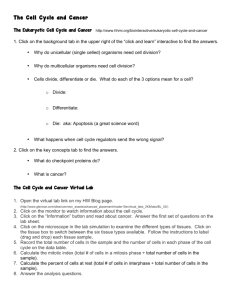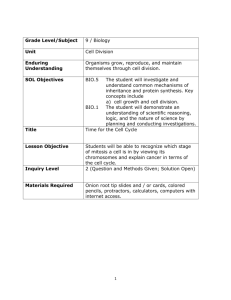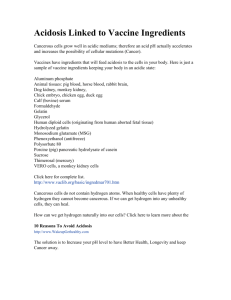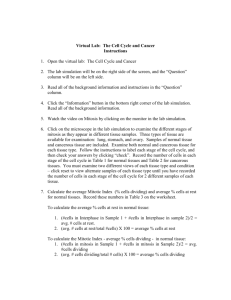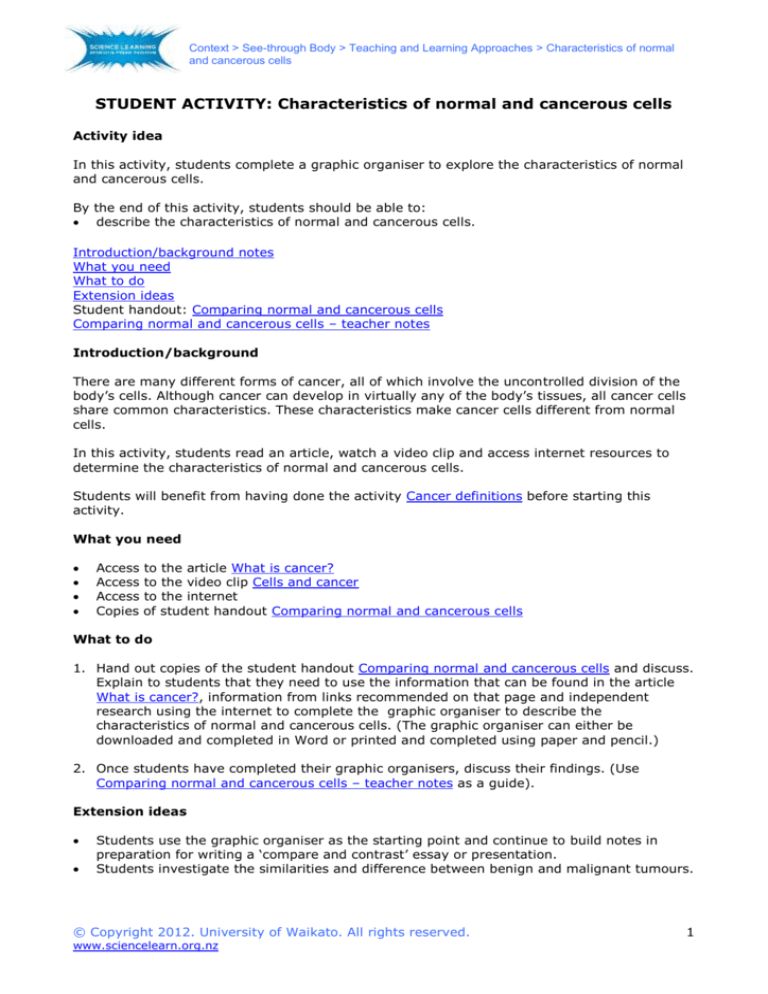
Context > See-through Body > Teaching and Learning Approaches > Characteristics of normal
and cancerous cells
STUDENT ACTIVITY: Characteristics of normal and cancerous cells
Activity idea
In this activity, students complete a graphic organiser to explore the characteristics of normal
and cancerous cells.
By the end of this activity, students should be able to:
describe the characteristics of normal and cancerous cells.
Introduction/background notes
What you need
What to do
Extension ideas
Student handout: Comparing normal and cancerous cells
Comparing normal and cancerous cells – teacher notes
Introduction/background
There are many different forms of cancer, all of which involve the uncontrolled division of the
body’s cells. Although cancer can develop in virtually any of the body’s tissues, all cancer cells
share common characteristics. These characteristics make cancer cells different from normal
cells.
In this activity, students read an article, watch a video clip and access internet resources to
determine the characteristics of normal and cancerous cells.
Students will benefit from having done the activity Cancer definitions before starting this
activity.
What you need
Access
Access
Access
Copies
to the article What is cancer?
to the video clip Cells and cancer
to the internet
of student handout Comparing normal and cancerous cells
What to do
1. Hand out copies of the student handout Comparing normal and cancerous cells and discuss.
Explain to students that they need to use the information that can be found in the article
What is cancer?, information from links recommended on that page and independent
research using the internet to complete the graphic organiser to describe the
characteristics of normal and cancerous cells. (The graphic organiser can either be
downloaded and completed in Word or printed and completed using paper and pencil.)
2. Once students have completed their graphic organisers, discuss their findings. (Use
Comparing normal and cancerous cells – teacher notes as a guide).
Extension ideas
Students use the graphic organiser as the starting point and continue to build notes in
preparation for writing a ‘compare and contrast’ essay or presentation.
Students investigate the similarities and difference between benign and malignant tumours.
© Copyright 2012. University of Waikato. All rights reserved.
www.sciencelearn.org.nz
1
Context > See-through Body > Teaching and Learning Approaches > Characteristics of normal
and cancerous cells
Student handout: Comparing normal and cancerous cells
Normal cell
Cancer cell
Compare and contrast with regards to….
Cell size and shape
Cell division and death
Specialisation of cells
Obeying signals
Cells sticking together
What is the key difference between normal cells and cancerous cells?
Conclusion
© Copyright 2012. University of Waikato. All rights reserved.
www.sciencelearn.org.nz
2
Context > See-through Body > Teaching and Learning Approaches > Characteristics of normal
and cancerous cells
Comparing normal and cancerous cells – teacher notes
Normal cell
Cancer cell
Compare and contrast with regards to….
Normal cells are uniform and
orderly.
Normal cells grow, divide and die
in a controlled way and with a
predictable lifespan. Normal cells
destroy themselves if they
become damaged (through a
process called apoptosis).
Normal cells become specialised
or ‘mature’. They start out as
immature cells (stem cells) and
acquire specific functions when
they mature.
Normal cell growth and healing is
very orderly and precise. The
cells know when there are
enough new cells to mend the
body. They send chemical
messages to each other so that
they stop growing and
reproducing.
Cells have a natural ability to
stick together in the right place.
Scientists call this cell adhesion.
Molecules on the surface of the
cell match those on its
neighbours.
Cell size and shape
Cell division and death
Specialisation of cells
Obeying signals
Cells sticking together
Cancer cells have large variations
in cell size and shape. Often, they
have a large irregularly shaped
nucleus and a relatively small
cytoplasm.
Cancer cells exhibit uncontrolled
growth as they have lost their
normal control mechanisms. They
grow and divide at a rapid rate
and they outlive their normal
lifespan (i.e. become immortal).
They may also be able to prevent
self-destruction when damaged.
Cancer cells do not carry on
maturing once they have become
cancerous. In fact, the cancer
cells can become less mature
over time. Cancer cells can lose
specialised functions and become
more and more primitive.
Something in the cancer cells
overrides the normal signalling
system. This may be because the
genes that tell the cell to
reproduce keep on and on
sending signals or because the
genes that normally tell the cell
to stop reproducing have been
damaged or lost.
Cancer cells can lose the
molecules on their surface that
keep normal cells in the right
place so they can become
detached from their neighbours.
What is the key difference between normal cells and cancerous cells?
Conclusion
The key difference between normal and cancerous cells is that cancer cells have lost the
restraints on growth that characterise normal cells.
© Copyright 2012. University of Waikato. All rights reserved.
www.sciencelearn.org.nz
3



